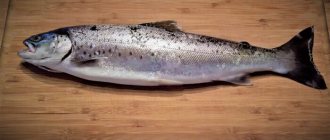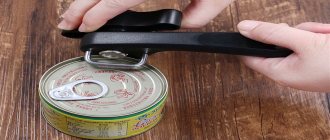Having just one fish knife won’t work – you need different types for cleaning scales, cutting, filleting, cutting into pieces, and serving.
They differ in shape, blade thickness and length, overall dimensions, and operating principle. For fresh and frozen fish you need one, and for salted and smoked fish you need another. Different tools are required for scaled and smooth-skinned carcasses. We'll tell you about classic options and new products, tell you which one to choose and reveal the secrets of using fish knives.
In this publication:
How to clean fish
Special knives for cleaning fish from scales are necessary for fishermen and those who prefer to buy live or frozen uncut carcasses.
This knife works on the principle of a scraper - a serrated blade removes scales from the skin, tearing it off. All fish scalers have a common operating principle, but each...
When choosing, it is important to take into account the size of the fish scales - a knife with small teeth will not cope with large scales. At the same time, high teeth will not do a clean job on a carcass with small scales and small fish.
Several serrated blades speed up the process - one removes scales, the second cleans up. But they cannot cope with large, tall scales; here it is more convenient to work with single-row, tall teeth that lift and cut off the scales.
To prevent scales from scattering all over the kitchen, they came up with a fish cleaning knife with a container in which all the waste is collected. After work, simply shake out the contents into the trash bin.
Criterias of choice:
- comfortable and non-slip handle;
- sharp cloves;
- Solid stainless steel, corrosion resistant.
Fish scalers with a plastic body are cheaper, but less durable and quickly break down. Durability also depends on the quality of the steel used for the blades.
Rules for choosing a device
To comply with sanitary and hygienic standards, there must be a separate product for cleaning fish in your kitchen. There are several rules that will help you choose a successful knife.
- Buy a product made of plastic or metal. Products with wooden handles contribute to the spread of bacteria. As a last resort, the wooden handle should be varnished.
- The handle of the fish scaler fits comfortably in the hand and is not very heavy.
- Choose a knife made of stainless steel with a high carbon content: such metals are less susceptible to corrosion and other types of damage.
- When purchasing a product for cleaning fish, make sure that the blade is not too thin and flexible, otherwise it will be very difficult to manipulate.
- A very wide, long and heavy product makes it difficult to manipulate the scales. Thin curved blades are good for removing bones and cutting fillets.
Fish cutting knives
A carving knife is needed to cut off the head and tail of the fish, make cuts to remove the entrails, and cut the carcass into portions. Here you need a reliable and practical assistant:
- with a hard, durable and straight blade with a length of 15 to 30 cm (depending on the size of the fish carcasses);
- with a wide base to cut off the head and tail in one fell swoop;
- with a pointed tip for ripping and notching;
- completely made of stainless steel, so as not to cause problems in washing and eliminate the absorption of odors;
- with a stop to prevent the index finger from slipping.
Often the non-working side of the blade is supplemented with teeth, thereby turning it into a fish scaler. Of course, you won’t be able to deal with large scales, but you can scrape off small scales or peel the skin.
Fish slicer knives are distinguished by an elongated wave-shaped blade with a built-up tip. The reliefs prevent the delicate flesh from sticking, facilitating a more accurate and smooth cut.
Separately, it is worth highlighting the ripper knife . If the carcass is small, then a regular knife will cope with the task of ripping open the belly, but for large breeds it is more convenient to use professional fish knives for gutting. They have a crescent-shaped blade about 16 cm long.
To cut raw fish, a Japanese knife with a blade in the shape of a willow leaf is traditionally used. The special sharpening of the sashimi knife allows you to cut without changing direction.
If you don’t want to buy a separate fish cutting knife, use a universal Japanese santoku; it does an excellent job of cutting fish of any size. A kitchen hatchet is suitable for separating the head and tail.
Criteria for selecting professional models
If you are in doubt about how to choose a suitable design, pay attention to the recommendations of specialists. There are parameters that require special attention:
| Type | Description |
| Power | The indicator is influenced by performance, network voltage, and rpm. Devices for 100 W and from 1000 to 1500 W are available. |
| Voltage | There are two options: 220 V and 380 V. |
| Performance | The parameter is very important. Much depends on the number of carcasses being cleaned. It is very important when purchasing a device for shops and restaurants. |
| Electric motor type | Models are available with single-speed and two-speed motors. This determines how much the unit costs. |
| Design Features | The devices differ in the types of attachments. They are for pink salmon, large-scaled specimens, and universal. |
Milling and thin slicing
A completely different knife is needed for filleting fish - separating the meat from the bones. This is where boning or fillet knives come in handy.
The “fillet” is distinguished by a flexible, long, thin, narrow and slightly curved blade, which can be easily inserted under the skin and pressed as close as possible to the spine. The blade sharpening angle is minimal.
Sometimes the blade is supplemented with notches - such “pockets” reduce the adhesion area and make the cut smooth and even. It’s good if there is a protrusion at the base of the blade at the transition point from the handle to the blade - it prevents the finger from slipping. This protrusion ensures not only safety, but also proper distribution of forces.
Using a fillet knife for cutting fish, fillet is separated, slices are cut for sandwiches and sushi, and the pulp is separated for cutlets and salads. To avoid damaging the flesh, use special fish tweezers to remove small bones.
Electric fish knives
Progress is gradually simplifying many kitchen tasks, including fish scales. An electric fish scaler removes fish scales without human effort and copes with scales of any size and varying hardness.
Electric knives for cleaning fish are either battery-powered or mains-powered. There are models powered from a car cigarette lighter. Autonomous ones are convenient in hiking conditions. For your home, it is better to choose a fish scaler with a protective casing to prevent scales from scattering around the kitchen.
For quick cutting, we came up with an electric fillet knife, which makes it much easier to separate the fillets and cut into neat slices.
There are also electric knives on sale that can cut bones. They help cut the carcass into even steaks with a smooth cut. When choosing, give preference to models that can handle frozen fish.
Secrets to quickly removing scales
- Before you start cleaning the fish, rinse it well under cold water. This removes mucus. It can be slippery and difficult to hold, especially when it is still covered in mucus. Rinse it so you can grip the fish firmly or hold it with a dry cloth or towel. This reduces the risk of the carcass moving during cleaning.
- Let the water drain for a few minutes to loosen the scales. Once you have removed the mucus, continue rinsing the fish. You can hold it yourself or leave it under running water while you take care of other things. This will help loosen the scales. Be sure to rinse both sides thoroughly.
- Place the fish on a protective layer. Put some kind of protection that will catch the scales that you will clean off. Choose something that you can throw straight into the trash. This can be newspaper, parchment paper or cardboard.
- Hold the fish firmly by the tail in your non-working hand. Hold the fish flat on the surface, but grip the tail to keep it from slipping as you begin to remove the scales. You can wear disposable gloves to protect your hands. Scales and fins may be sharp.
- Hold the knife in your dominant hand and turn it toward the blunt edge. To remove scales, use the dull edge of a knife instead of a sharp edge. Hold the blunt edge at a 45 degree angle. Place the blunt edge directly against the fish's skin near the tail fin.
- Scrape the side of the fish from the tail to the head. Make long, even strokes. You will need to apply a little pressure, but not too much. If you scratch, the scales will start to pop out. Continue until there are no scales left on that side. Turn the fish over and repeat on the other side.
- Rinse the remaining scales with cold water. After you have removed all the scales with a knife, hold the carcass under cold running water. The water should help remove any scales that are still on the fish. Continue rinsing until no scales remain.
Cleaning fish with a knife.
Serving fish knives
The idea that all fish is eaten with hands is incorrect. According to etiquette, the fish is served with a special fork and knife, which is not used to cut, but to remove the fillet from the bones or separate a small piece along the fibers. The bones are not cut! The peel is removed using the built-up tip, holding the piece with a fork. Bones and other waste are placed in a special plate for bones.
Table fish knives for serving the table are distinguished by a peculiar blade shape with a sharp tip and an upward blade line. There is a slight bevel on the butt. The blade in relation to the handle is located at a slight angle, like a spoon or fork. The length of the blade is from 19 to 21 cm, the handle is always longer than the working part.
Fish shoulders are served with large fish, cooked whole. Large blades are intended for those cases when the carcass is served on a common table. Smaller shoulder blades are portioned, when each guest is given a portion with a whole carcass.
First of all, use a spatula to separate the head and tail, then with the sharp side they cut along the belly and back and, picking up the skin at the tail, screw it onto the spatula, carefully removing it. After eating the fillet on one side, the carcass is turned over and the second part is eaten.
Serving knives for fish dishes are made of stainless steel, cupronickel, and silver. The decor uses a neutral or fish theme. Sold separately and in a set with fish forks. Rarely included in cutlery sets.
Tips from experts on cleaning fish carcasses
To ensure that the final result is positive and the work does not take up a lot of free time, you must follow the following recommendations of professional chefs and experts:
- Clean scales from freshly caught fish. If she lies down for a while, certain difficulties will arise.
- If a lot of time has passed since catching, you should put the fish in a bowl of cold water and add a little vinegar.
- Do not hurry. Everything needs to be done measuredly. The carcass must be completely freed from the husk, and this must be done very carefully.
- The carcass is processed on a cutting board specially purchased for this purpose.
- For fixation it is necessary to use special clamps or improvised means.
- Cleaned fish is thoroughly washed under running water.
- Catfish and burbot require subsequent rubbing with salt.
You can also clean the fish with a regular knife. The absence of a container will allow the husks to fly away in all directions. To prevent this from happening, you need to place the carcass in a plastic bag. Its size should be such as not to hinder the movement of the master.
If there is an avid fisherman in the family, then the housewives know what a big difference there is between cleaning a small fish and a large carcass. Special devices will help you get the job done quickly and efficiently. So, if you have to manipulate a fatty small fish, then a round scraper will be the best assistant. If you are cooking pike, bream, or pike perch, then you need to give preference to a thin metal knife. Mechanical devices are more suitable for household use. It is advisable that they have a clip as an additional accessory so that the fish does not escape. This device resembles a clothespin and secures the tail. For cleaning fish on an industrial scale, it is better to purchase electric units.
As a rule, all blades are made of stainless steel. It is easy to wash, it is not afraid of moisture, and does not corrode. Resistant to significant temperature changes. In this case, the location of the blades may be different. The most common option is vertical. Convenient and practical, helps to quickly cope with the task. No special skills are required to use it. Even a beginner can handle the job. When positioned horizontally, the device will have to be held at a certain slope, which leads to additional stress on the hands. If the tool is sold with a special attachment, then it can not only clean, but also cut up carcasses.
Review of fish knives
In this section we want to show interesting, in our opinion, knives for fish.
Fish scaler with a container for collecting scales and a retractable ripper. Used for cleaning and gutting. Suitable for processing small volumes of fish with soft and small scales.
“Beluga” is a convenient cutting knife for large fish with a sawtooth sharpening on the spine, which can be used for cleaning short scales.
The Japanese knife “Deba Samura SO-0129” for cutting fish with a traditional Japanese one-sided sharpening is intended for rough cutting. It easily copes with carcasses of different sizes and is indispensable when you need to cut off the tail or head of a whole carcass or divide a balyk into portions. The blade is made of AUS-8 stainless steel, hardness: 58. The wooden handle is made of rosewood.
The table set of a knife and fork for fish dishes is made as a gift. All the structural features of cutlery for fish appetizers are clearly visible here.
The elegant serving fish knife-spatula “Trianon” is made of 925 sterling silver. A gift option for those who love luxury tableware that is passed down from generation to generation. The spatula is used to serve fish dishes on a common table.
Tips for quickly processing fish
To prevent the fish from slipping, purchase a special cutting board with a clothespin that secures the fish by the tail. Or, as an option, you can fix the carcass with a fork by sticking it into the board.
It is best to secure the fish.
If the fish cannot be cleaned, cover the fish with salt in a thick layer and leave overnight.
Try to get rid of the scales while the fish is still wet. If the scales are dry, keep the fish in water until the scales become wet again.
If the scales are large, to better separate them from the carcass, scald the fish with boiling water.
Start processing after 20 minutes.
Professional Series
The line of professional knives for cleaning, cutting and filleting fish is aimed at fishermen and chefs. Here you can find chef's tools of different sizes, made of durable and practical materials.
A professional chef always has several knives in his arsenal, from which he chooses the most suitable one, taking into account the size of the carcass and the characteristics of its scales. Also, professional knives, including electric ones, are used at points of sale to prepare and cut carcasses for customers.
Fishing knives should not only be functional, but also mobile. Often several functions are combined in one product so that the fisherman does not have to carry a large set with him.
The best fish scaler models from AliExpress
It's no secret that one of the most advertised and accessible trading platforms is AliExpress. A colossal amount of all kinds of goods at the most attractive prices is concentrated here. The popular online store allows you to place an order online from anywhere in the world. It is here that we found several models of fish scalers that deserve attention.
Fishka Messer LK-859B
This popular electric model is produced by the famous Chinese brand Messer. The design is in such high demand largely due to the lack of need for direct connection to a power source. The device operates via a built-in battery from a foreign manufacturer, which allows you to clean large-scaled and small-scaled fish near the catch site. The presence of a protective casing, which protects the mechanical elements of the structure from various mechanical damage, deserves special attention. The risk of husk accumulation inside the product is eliminated. There is also a reverse option, which will allow you to quickly and effectively remove debris during the cleaning process. The case is protected from moisture, which will allow you to use the item while fishing. The device is equipped with a power cord, compact charger, instructions and warranty.
Cost – 4200 rub.
Fishka Messer LK-859B
Advantages:
- reverse option;
- small weight of fish scaler;
- speed of manipulation;
- ease of operation;
- built-in battery;
- waterproof housing;
- optimal power;
- high autonomy.
Flaws:
- not identified.
Halojaju zuan791
The rating of high-quality Chinese fish scalers continues with a model that can be bought on Aliexpress. An inexpensive but effective device will help remove the husks and entrails of fish of any size. This was achieved largely due to the presence of jagged edges on the knife. The blades are at different angles relative to the handle, which allows manipulation in any direction. You should also pay attention to the presence of several auxiliary holes used for subsequent removal of debris. The design allows you to open bottles. Stainless steel is used as the main material. Handle length – 190 mm. According to buyers, the handle lacks design, causing the material to slip, which can lead to injury.
Cost – 315 rubles.
Halojaju zuan791
Advantages:
- good location of the blades;
- ease of use;
- budget price;
- long service life;
- multifunctionality.
Flaws:
- uncomfortable handle shape.
LEFIN Scaler M505
One of the best fish scalers found on the Chinese platform. Externally it resembles a pencil sharpener. For greater ease of use, the design is equipped with a container where all garbage goes. The scraper is made of durable plastic. The edges are ribbed, so the removal of the husk occurs without any effort on the part of the owner. A latch is used to secure the cover. The container is washed under running water. The grooves are responsible for preventing slipping, and at the same time they also perform decorative functions. Based on the characteristics declared by the manufacturer, there is a small hole on the handle that can be used for subsequent suspension.
Cost – 300 rub.
LEFIN Scaler M505
Advantages:
- with container;
- attractive price;
- safety;
- ease of use;
- compact dimensions.
Flaws:
- not identified.
Promonova
This is the kind of company that is best to buy a device for cleaning fish if you have a limited budget. Based on numerous reviews, the thoughtful design of the case deserves special attention. Also, the popular model is characterized by its compact size. It is recommended by both experienced housewives and professional chefs, which is surprising for this price category. There is also a convenient transparent container for collecting scales, which will allow you to monitor the degree of its fullness and carry out timely cleaning. The handle material is stainless steel, which guarantees a long service life. There is a retractable knife, which will reduce cleaning time and perform all the necessary manipulations with one device.
Cost – 155 rubles.
Promonova fish scaler
Advantages:
- wide range of colors;
- thoughtful design;
- transparent type container;
- compact dimensions;
- hidden functionality in the form of a knife;
- strong appearance.
Flaws:
- not identified.











